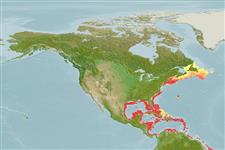Common names from other countries
Environment: milieu / climate zone / depth range / distribution range
Ecologia
; intervalo de profundidade 29 - 185 m (Ref. 1821). Tropical
Western Atlantic: USA, Canada and Caribbean.
Length at first maturity / Tamanho / Peso / Idade
Maturity: Lm ? range ? - ? cm Max length : 0.4 cm DL macho/indeterminado; (Ref. 83435)
Maximum depth from Ref. 111279.
Life cycle and mating behavior
Maturidade | Reprodução | Desova | Ovos | Fecundidade | Larvas
Members of the class Scaphopoda are gonochoric. Fertilization occurs in the mantle cavity. Life cycle: Eggs hatch into free-swimming lecithotrophic trochophore larvae, succeeded by shelled veligers.
Steiner, G. and A.R. Kabat. 2004. (Ref. 1821)
Categoria na Lista Vermelha da IUCN (Ref. 130435)
Categoria CITES (Ref. 108899)
Not Evaluated
Not Evaluated
Utilização humana
| FishSource |
Ferramentas
Mais informação
Idade/Tamanho
Crescimento
Comprimento-peso
Comprimento-comprimento
Morfologia
Larvas
Abundância
Fontes da internet
Estimates based on models
Preferred temperature
(Ref.
115969): 0.5 - 26.3, mean 19 (based on 185 cells).
Categoria de preço
Unknown.
